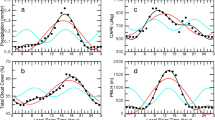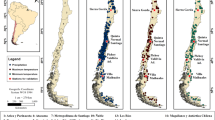Abstract
Previous evaluations of model precipitation fields have suffered from two weaknesses; they have used only mean observed climatologies which have prevented an explicit evaluation of interannual variability, and they have generally failed to quantify the significance of differences between model and observed fields. To rectify these weaknesses, a global precipitation climatology is required which is designed with model evaluation in mind. This paper describes such a climatology representative of the period 1951–80. The climatology is based on historical gauge-precipitation measurements from over 2500 land-based station time series representing over 28% of the Earth's surface. It is necessarily biased towards terrestrial areas. The climatology (CRU5180) is derived from month-by-month gridbox precipitation estimates at 5° resolution. Although other global precipitation climatologies exist, this is the first one to have used a consistent reference period for each station, and to include the details of interannual variability. Fields of mean seasonal and annual precipitation and mean temporal variability are presented, and the variability of global-mean precipitation over 1951–80 assessed. The resulting mean monthly global precipitation fields are compared briefly with two other observed climatologies used for model evaluation, those prepared by Jaeger and Legates and Willmott. The global and hemispheric means, mean seasonal cycles, and spatial patterns of the three cimatologies are compared. Although based on a smaller set of stations than Legates and Willmott, the CRU5180 precipitation estimates agree closely with their uncorrected climatology.
Similar content being viewed by others
References
Arkin PA, Ardanuy PE (1989) Estimating climatic-scale precipitation from space: a review. J Climate 2:1229–1238
Bradley RS, Jones PD (1985) Data bases for isolating the effects of the increasing carbon dioxide concentration. In: MacCracken, MC, Luther FM (eds) Detecting the climatic effects of increasing carbon dioxide. US DoE, DOPE/ER-0235, Washington DC, pp 29–54
Bradley RS, Diaz HF, Eisheid JK, Jones PD, Kelly PM, Goodess CM (1987a) Precipitation fluctuations over Northern Hemisphere land areas since the mid-19th century. Science 237:171–175
Bradley RS, Diaz HF, Kiladis GN, Eischeid JK (1987b) ENSO signal in continental temperature and precipitation records. Nature 327:497–500
Creutin JD, Obled C (1982) Objective analysis and mapping techniques for rainfall fields: an objective comparison. Water Res Res 18:413–431
Diaz HF, Bradley RS, Eischeid JK (1989) Precipitation fluctuations over global land areas since the late 1800s. J Geophys Res 94:1195–1210
Eischeid JK, Diaz HF, Bradley RS, Jones PD (1991) A comprehensive precipitation data set for global land areas. US Department of Energy Report No. DOE/ER-69017T-Hl, Washington DC, 81 p
Farmer G (1989) Rainfall. In: The IUCN Sahel Studies, 1989. IUCN, Gland, Switzerland, pp 1–25
Finkelstein PL, Truppi LE (1991) Spatial distribution of precipitation seasonality in the United States. J Climate 4:373–385
Folland CK, Karl T, Vinnikov KYa (1990) Observed climate variations and change. In: Houghton JT, Jenkins GJ, Ephraums JJ (eds) Climate change: the IPCC scientified assessment. Cambridge University Press, Cambridge, pp 195–238
Folland CK, Owen JA, Ward MN, Colman AW (1991) Prediction of seasonal rainfall in the Sahel region using empirical and dynamical methods. J Forecasting 10:21–56
Gates WL, Rowntree PR, Zeng Q-C (1990) Validation of climate models. In: Houghton JT, Jenkins GJ, Ephraums JJ (eds) Climate change: the IPCC scientific assessment. Cambridge University Press, Cambridge, pp 93–130
Geiger R (1965) Wandkarten, 1:30 Million. Jährlicher Niederschlag, Darmstadt
Glantz MH, Katz RW, Nicholls N (1990) Teleconnections: linkages between ENSO, worldwide climate anomalies and societal impacts. Cambridge University Press, Cambridge
Gleick PH (1987) Regional hydrologic consequences of increases in atmospheric CO2 and other trace gases. Climatic Change 10:137–61
Grotch SL (1988) Regional intercomparisons of General Circulation Model predictions and historical climate data. Report prepared for the DoE under Contract No. W-7405-ENF-48, Washington DC, 292 p
Houghton JT, Jenkins GJ, Ephraums JJ (eds) (1990) Climate change: the IPCC scientific assessment. Cambridge University Press, Cambridge
Hulme M (1991) An intercomparison of model and observed global precipitation climatologies. Geophys Res Lett 18:1715–1718
Hulme M, Marsh R (1990) Global mean monthly humidity surfaces for 1930–59, 1960–89 and projected for 2030. Report prepared for UNEP/GEMS/GRID (Nairobi), Climatic Research Unit, Norwich
Jaeger L (1976) Monatskarten des Niederschlags für die ganze Erde. Berichte des Deutschen Wetterdienstes, 18, No. 139, Offenbach, FRG
Jones PD (1987) The early twentieth century Arctic high — fact or fiction? Clim Dyn 1:63–75
Jones PD (1988) Large-area precipitation fluctuations: a comparison of grid-based and areal precipitation estimates. In: Gregory S (ed) Recent climatic change. Belhaven Press, London, pp 30–40
Jones PD, Raper SCB, Bradley RS, Diaz HIT, Kelly PM, Wigley TML (1986a) Northern Hemisphere surface air temperature variations, 1851–1984, J Climate Appl Met 25:161–179
Jones PD, Raper SCB, Wigley TML (1986b) Southern Hemisphere surface air temperature variations, 1851–1984. J Climate Appl Met 25:1213–1230
Kiladis GN (1988) Some comments on the T21 Model's precipitation climatology. In: Max-Planck-Institut für Meteorology, Report No. 16, Hamburg, pp 53–64
Kirkyla KI, Hameed S (1989) Harmonic analysis of the seasonal cycle in precipitation over the United States: a comparison beween observations and a General Circulation Model. J Climate 2:1463–1475
Lebel T, Bastin G, Obled C, Creutin JD (1987) On the accuracy of areal rainfall estimation: a case study. Water Res Res 23:2123–2134
Leemans R, Cramer WP (1990) The IIASA database for mean monthly values of temperature precipitation and cloudiness on a global terrestrial grid. Working Paper No. WP-90–41, Biosphere Dynamics Project, IIASA, Laxenburg, Austria
Legates DR (1991) An evaluation of procedures to estimate monthly precipitation probabilities. J Hydrology 125:129–140
Legates DR, Willmott CJ (1990) Mean seasonal and spatial variability in gauge-corrected, global precipitation. Int J Clim 10:111–128
MacCracken MC, Luther FM (eds) (1985) Detecting the climatic effects of increasing carbon dioxide. Department of Energy, Carbon Dioxide Research Division, Washington DC
Nicholls N, Wong KK (1990) Dependence of rainfall variability on mean rainfall, latitude, and the Southern Oscillation. J Climate 3:163–170
Pettit AN (1979) A non-parametric approach to the change-point problem. Appl Statistics 28:126–135
Pitman AJ, Henderson-Sellers A, Yang ZL (1990) Sensitivity of regional climates to localized precipitation in global models. Nature 346:734–737
Ropelewski CF, Halpert MS (1987) Global and regional scale precipitation patterns associated with the El Nino/Southern Oscillation. Mon Wea Rev 115:1606–1626
Ropelewski CF, Jones PD (1987) An extension of the Tahiti-Darwin Southern Oscillation Index. Mon Wea Rev 115:2161–2165
Rudolf B, Hauschild H, Reiss M, Schneider U (1991) Operational global analysis of monthly precipitation totals planned by the GPCP. Dynam Atmosph Oceans (in press)
Santer BD, Wigley TML (1990) Regional validation of means, variances and spatial patterns in GCM control runs. J Geophys Res 95:829–850
Schlesinger ME, Mitchell JFB (1987) Climate model simulations of the equilibrium climate response to increased carbon dioxide. Rev Geophys 25:760–798
Sevruk B (1982) Methods of correcting for systematic error in point precipitation measurement for operational use. Operational Hydrology Report No. 21, WMO No. 589, Geneva
UNIRAS (1989) UNIRAS graphics manual. UNIRAS A/S, Soborg, Denmark
UNESCO (1978) World water balance and water resources of the earth. UNESCO Series Studies and Reports in Hydrology, 25, Leningrad
US Navy (1965) US Navy Marine atlas of the world, Vols. 1–7 (1955–65). US Office of Naval Operations, Washington DC
Vinnikov KYa, Groisman PYa, Lugina KM (1990) The empirical data on modern global climate changes (temperature and precipitation). J Climate 3:662–677
Wigley TML, Barnett TP (1990) Detection of the greenhouse effect. In: Houghton JT, Jenkins GJ, Ephraums JJ (eds) Climate change: the IPCC scientific assessment. Cambridge University Press, Cambridge, pp 239–255
Wigley TML, Santer BD (1990) Statistical comparison of spatial fields in model validation, perturbation, and predictability experiments. J Geophys Res 95:851–865
Wilson CA, Mitchell JFB (1987) A doubled CO2 climate sensitivity experiment with a global climate model including a simple ocean. J Geophys Res 92:13315–13343
Author information
Authors and Affiliations
Rights and permissions
About this article
Cite this article
Hulme, M. A 1951–80 global land precipitation climatology for the evaluation of general circulation models. Climate Dynamics 7, 57–72 (1992). https://doi.org/10.1007/BF00209609
Received:
Accepted:
Issue Date:
DOI: https://doi.org/10.1007/BF00209609




